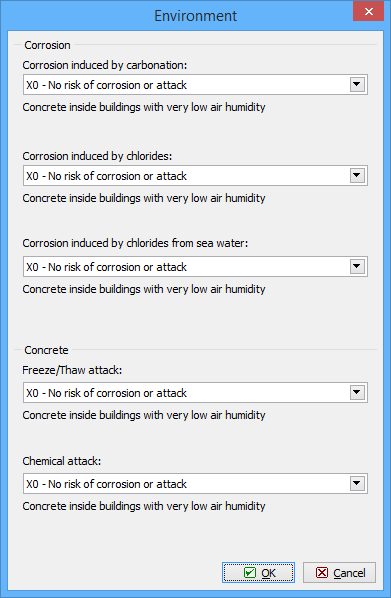Environment
The environmental conditions for a member can be specified in this window. The range of conditions is based on the chapter 4.2 of EN 1992-1-1. The conditions influence the calculation of minimum (indicative) strength class and minimum reinforcement cover. These procedures are described in the chapters "Indicative strength class" and "Minimum cover" of theoretical help.
Description of options:
Corrosion induced by carbonation
X0 - No risk of carbonation |
|
XC1 - Dry or permanently wet |
|
XC2 - Wet, rarely dry |
|
XC3 - Moderate humidity |
|
XC4 - Cyclic wet and dry |
|
Corrosion induced by chlorides
X0 - No risk |
|
XD1 - Moderate humidity |
|
XD2 - Wet, rarely dry |
|
XD3 - Cyclic wet and dry |
|
Corrosion induced by chlorides from sea water
X0 - No risk |
|
XS1 - Exposed to airborne salt but not in direct contact with sea water |
|
XS2 - Permanently submerged |
|
XS3 - Tidal, splash and spray zones |
|
Freeze/Thaw Attack
X0 - No risk |
|
XF1 - Moderate water saturation, without de-icing agent |
|
XF2 - Moderate water saturation, with de-icing agent |
|
XF3 - High water saturation, without de-icing agents |
|
XF4 - High water saturation with de-icing agents or sea water |
|
Chemical attack
X0 - No risk |
|
XA1 - Slightly aggressive chemical environment according to EN 206-1, Table 2 |
|
XA2 - Moderately aggressive chemical environment according to EN 206-1, Table 2 |
|
XA3 - Highly aggressive chemical environment according to EN 206-1, Table 2 |
|
 Window "Environment"
Window "Environment"